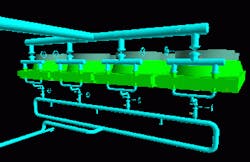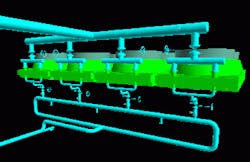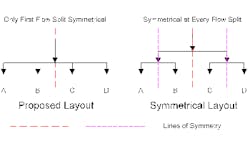How Important is Piping Symmetry?
When we build multiple parallel exchangers we assume an ideal world -- each exchanger getting the same flow. One way of achieving equal flow to every exchanger is making inlet and outlet piping symmetrical. So, my first thought on seeing the piping layout proposed for connecting a tower overhead to an air-fin condenser (Figure 1) was "That's not symmetrical." Tower overhead enters in the large line from the upper left and goes to the condenser; condensate then leaves through the line to the lower left. Both the inlet and outlet piping clearly aren't symmetrical, despite the designer being instructed to provide a symmetrical layout.
My second thought was "Is symmetry important here?" To evaluate this, let's look at the inlet piping because non-symmetry in the outlet piping here only has a minor impact.
Figure 2 shows a schematic of proposed inlet piping. It has a line of symmetry at the first flow split. As far as the piping designer was concerned this was a symmetrical layout. However, to get the exact same resistance to flow in each path, every split must be symmetrical to every other one at the same level of branching. For four inlet lines, a symmetrical layout requires two levels of branching: the first sends flow to AB and CD, the second splits that to A and B and C and D.
To analyze the system, we start with one flow fundamental -- pressure drop in parallel paths must be equal. Flow and level, if present, will distribute to equalize pressure drop. For the proposed layout, this translates to 107% of design flow going to inner bays (B and C) and 93% to outer bays (A and D), or inner bays receiving 115% of the flow of outer ones.
While this seems like a lot, what's the real consequence? Do we really care about the maldistribution? What really counts is its impact on exchanger duty. Bays with low flow will tend to pinch against air temperature (reducing duty). Bays with high flow may be limited by surface area or may compensate due to increased temperature difference (because their outlet temperature rises).
A detailed analysis of exchanger performance shows duty in the high-flow bays (B and C) goes up, duty in the low-flow bays (A and D) goes down, and total duty drops slightly, by 0.4%.
The exchanger was being purchased with 25% more duty capability than required. Additionally, the non-symmetrical piping minimized structural height and reduced overhead-of-tower-to-condenser-drum pressure drop, which was important as well. Overall, the non-symmetrical layout was a better design. So, the answer to my second question is "No, symmetry's not important here."
Not every flow-splitting problem will have the same answer. How important is symmetry? You only can tell through a detailed evaluation of the specific situation.
This case had several key factors making symmetry less important:
• relatively high fraction of system pressure drop in exchangers compared to piping;
• large difference between outlet temperature of process stream and air stream from condenser; and
• ample over-design in exchangers.
Symmetry is more important in overhead systems when you must deal with factors such as:
• close temperature pinches between process and cooling medium; and
• low system pressure, as this magnifies the impact of pressure drop on the condensation curves.
Symmetry in piping is a good first step to achieve even flow and maximum equipment performance. However, in some systems, like the one here, it may not be worth the price. But don't decide without careful analysis.
Andrew Sloley is a Contributing Editor to Chemical Processing. You can e-mail him at [email protected].


